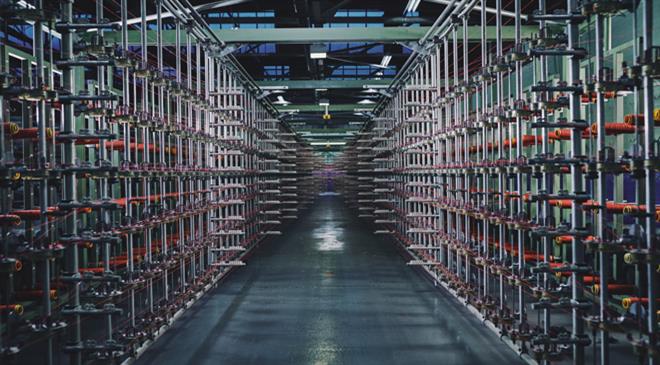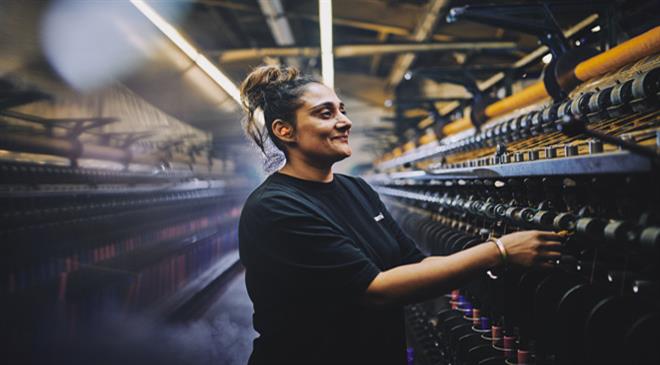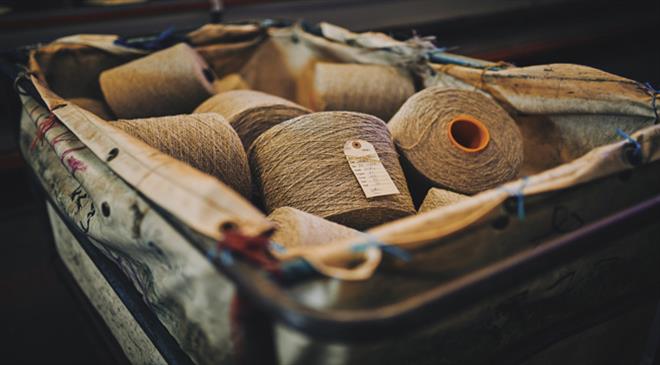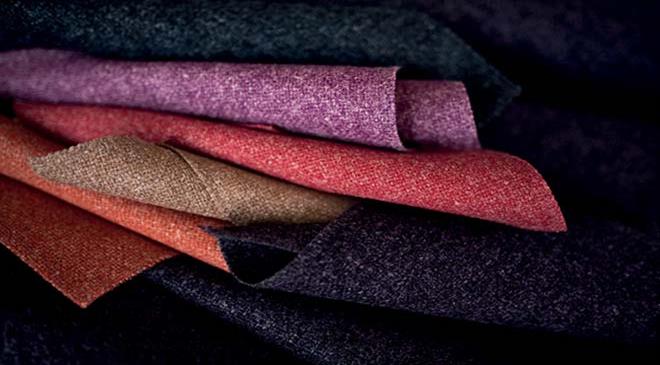From farm to fabric and everything in between
Camira's expertise goes from farm to fabric and everything in between. The company makes fabrics for spaces and places from offices to universities, hotels to hospitals, for buses to trains. In an interview with Paulami Chatterjee, Ian Burn, Director - Marketing of Camira Fabrics, talks about the company's epic journey till date and the kind of expansion plans it has for future.
How has the journey been from Camborne Fabrics to Camira? Which new companies and capabilities have you acquired through the years?
It's been an epic journey, spanning five decades and five continents. Camborne Fabrics started in 1974 in the UK and at first worked with commission weavers before starting its own manufacturing in the late 1980s. The business was acquired by the US carpet tile company Interface, Inc in 1997, and a year later became Interface Fabrics until a management buy-out 9 years later led to the formation of Camira. There have been numerous acquisitions along the way to take the company into new market segments (eg British Furtex Fabrics Ltd and John Holdsworth & Co in the transportation fabric sector) or acquire new manufacturing capabilities (eg Teknit for technical knitting, Nortex for polypropylene yarn, Stork Brothers for woolen yarn spinning). The two most recent acquisitions are Holmfirth Dyers (piece dyeing and finishing) and Luna Textiles (a North American textile jobber), both in 2019. Along the way we've also become a global leader in environmental textiles, innovating a totally new category of natural fibre fabrics made from wool and harvested plants such as nettles, hemp and flax.
What is your annual production capacity?
Last year we made over 9 million metres of fabric.
What type of finishings are in most demand when it comes to fabrics for commercial interiors?
Natural fibres - wool and wool-bast fibre blends - are in demand for soft seating such as sofas, collaborative furniture and pods, due to their inherent benefits of upholsterability, appearance and performance. Velvets are also becoming popular due to their softness and residential feel. As mentioned above, there is a mix of flat-woven, velvet pile, knitted, and also printed fabrics.

How would you describe the fabric market for the commercial interiors industry in UK? What factors have a huge influence on this sector?
The fabric market for commercial interiors covers a broad cross-section of end-use areas including commercial offices, higher education (universities), hospitality and leisure (hotels, restaurants, cinema and auditoria) and healthcare (residential care homes, nursing homes, hospitals, doctors' surgeries).
There are numerous factors which influence this sector, one of which is the so-called 'resimmercial' trend, which is a blurring of boundaries between the home, workplace, universities and hotels. Interiors have become more relaxed and less formal, fueling the growth of collaborative workspaces where larger pieces of ancillary furniture are the norm. As spaces have been opened up, acoustics have become a much bigger topic which has also raised wider discussions on health and wellbeing. And ofcourse on top of all this is the renewed emphasis on sustainability, thanks to the 'Greta' effect and plastic backlash.

What is the market share of interior fabrics within the overall fabrics market in UK?
It is difficult to be precise about market share information due to the absence of formal market statistics and the blurring of boundaries between segments.
What will be the trends for the summer of 2021?
Looking ahead to 2021, we are predicting soft geometrics and tweeds will be big. Additionally, mini patterns and semi-plains are something we are homing in on - of course making sure they coordinate beautifully with our plain fabrics.
What kind of new researches are you doing now keeping in mind the various characteristics of interior fabrics?
We are an industry partner of the Future Fashion Factory and we are looking to explore new flame retardants and finishing technologies which will enable us to offer our fabrics in new markets, improving safety whilst minimising environmental impacts.
In 2020 we will also be working with partners to explore how our fabrics can make a greater contribution to room and building acoustics. This is a growth area as we consider workplace wellbeing and creating quality hospitality environments.
Has Brexit had any impact on the commercial interior's fabric market?
Brexit has generally dampened demand in the past 12 months due to the widespread uncertainties around supply chain and distribution issues.
Where are your factories based at? From where do you source the raw materials?
The bulk of our manufacturing facilities are located in the United Kingdom in the West Yorkshire area. We have five factories where we spin wool yarn, make and weave air textured polypropylene, weave finished fabrics, and dye both yarn and woven fabric. Our technical knitting plant is in Nottingham and our major mainland European facility is located in Lithuania, where we weave fabrics and provide a wide range of upholstery services.
We source materials globally as well as from the UK, working with select long-term partners who can fulfil our specific requirements, including quality, capacity, environmental and social parameters.

Can we expect any expansion or product launch announcements soon?
Yes, we have a very exciting product launch pipeline throughout this year, starting in the spring with our first recycled polyester which incorporates plastic sea waste. This fabric is called Oceanic and is part of the Seaqual Initiative to achieve a waste free environment, building on our 20-year pedigree of designing recycled polyester fabrics. Another soon to be launched upholstery fabric is a new velvet called Regent, which is an ultra-soft yet durable solution for commercial and hospitality interiors. Later this spring, we'll be launching innovative new products, including a vertical surface fabric made from cork, and an upholstery fabric which is like a sheep's fleece using undyed natural wool.

What steps do you take to ensure sustainability across your value chain?
Sustainability and corporate social responsibility have been at the heart of the Camira culture right since the days of Camborne Fabrics. Camborne was actually one of the very first textile companies anywhere in the world to achieve the environmental management system back in the 1990s and had already implemented ground-breaking manufacturing initiatives, especially in relation to water usage in the scouring process. Becoming part of the Interface organisation put greater focus on environmental product design and development, creating several industry first fabrics, including ReSKU made from recycled wool army jumpers, Ecollection using environmentally sensitive non-metallic dyestuffs, and numerous recycled polyesters made from both post-industrial and post-consumer raw materials. Beyond Interface, Camira innovated a totally new category of environmental fabrics made from wool blended with naturally occurring plant based fibres, starting with nettles, then expanding to hemp and flax. Camira has also developed products made using closed loop waste inputs, including waste fabric and yarn upcycled back into fabric, as well as upcycled coffee sacks.
A key part of the sustainability strategy across the value chain over the last decade has been the vertical integration of the major elements of the textile manufacturing process. This began with extending into yarn manufacturing - wool spinning and polypropylene air texturing - then moved into package yarn dyeing and most recently fabric piece dyeing. We also work directly with farmers for wool and bast fibre crops, meaning that Camira goes from farm to yarn, and from yarn to finished fabric, handling every process in between. Clearly this gives a far greater degree of environmental control, managing ingredients, energy and water usage, and in some instances opened up new environmental product possibilities, notably blending wool with plant based fibres to spin new environmental yarns. Where we do partner with third party suppliers, they must fulfil stringent environmental audits.
Which are your major domestic and export markets? Which new markets do you plan to explore?
Our largest market is in our home UK territory, but overall, we actually export more than we sell domestically, with exports around 65 per cent of our total turnover. Our largest overseas markets are US, Germany, the Scandinavia region, Poland, France and the Benelux region. We sell to around 80 countries every year. Our major focus is not on new geographic areas or market segments, but continued expansion in our core export markets in North America and Europe and continued progress in Asia Pacific and the Middle East and India.
Who are your major customers from each of the industry segments you cater to?
In commercial interiors, our direct customers are the furniture manufacturers who make seating, systems furniture and acoustic solutions. We also have important influencers and specifiers we need to reach, including furniture dealers, the architect and design community, design and build specialists, and we sometimes go direct to end-user clients.
The passenger transport market (buses, coaches, trains) includes an equally wide array of customers: seat makers, refurbishers, vehicle builders, public transport operators, design houses.
How difficult or easy is it to get the right type of skill sets in people specific to your industry?
This can sometimes be quite challenging, as textile manufacturing is not always thought to be as attractive as some other industry sectors, for example ICT or engineering, especially to young people starting out on their career. However, we work closely with local schools and colleges near our UK manufacturing HQ and run a successful modern apprenticeship programme which is designed to ensure young people are able to train and learn key job skills at the same time. This has enabled us to nurture the stars of the future, and we're a forward-thinking business, with excellent working environments and terms and conditions which is good for retention. Within the business, whether in UK or Lithuanian manufacturing, we provide excellent training and career development opportunities.
What is the attrition rate? Any steps that your company takes that helps retain staff?
There is generally a low attrition rate and retention is helped by training and development opportunities, opportunities for career progression, comfortable and pleasant workplaces and factories, decent employment benefits, and being part of a genuinely innovative, ambitious, successful global organisation.
What are your core competencies for export markets? Which fabrics and blends are popular in export markets?
We're a global organisation with a wide network of international offices and warehousing in strategic regions, so we're within easy reach of our global clients. Global distribution is a core competency and we have a very broad product portfolio, which - very importantly - can fulfil the multitude of flammability requirements in different regions. Environmental standards, such as the EU Ecolabel, OekoTex, and, increasingly, Indoor Air Quality are also very important.
Our most popular fabrics at home and abroad are our felted wools (Blazer and Synergy) and our crepe weave polyesters such as Xtreme, Lucia and Phoenix. In the UK and North America, our colour-woven classic wool and wool blend dobbies are also very popular. There is an interest in surface texture, both finer and chunkier, and technical knits are on trend for task seating.
Please share details of the last fiscal and the target set for the current year.
In 2019 we surpassed £100 million for the first time. Our end of year figures are still being finalised.





